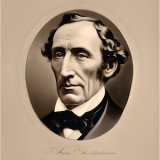Little Tiny or Thumbelina Page #3
In "Little Tiny or Thumbelina," author Hans Christian Andersen introduces readers to Tiny, a lovely girl no bigger than a thumb. She is brought into the world inside a barleycorn given to a woman by a witch. Thumbelina's adventures begin when she is kidnapped from her cozy home by an ugly toad, desiring her as a bride for her son. Thumbelina's journey takes her to many unknown, dangerous places, filled with monstrous creatures. Despite her trials, Thumbelina never loses her courage, for she is a kind-hearted creature. The tale underscores the classic theme of good triumphing over evil, ending with Thumbelina's reunion with loving, beautiful creatures just like her.
Then she brought the swallow some water in a flower-leaf, and after he had drank, he told her that he had wounded one of his wings in a thorn-bush, and could not fly as fast as the others, who were soon far away on their journey to warm countries. Then at last he had fallen to the earth, and could remember no more, nor how he came to be where she had found him. The whole winter the swallow remained underground, and Tiny nursed him with care and love. Neither the mole nor the field-mouse knew anything about it, for they did not like swallows. Very soon the spring time came, and the sun warmed the earth. Then the swallow bade farewell to Tiny, and she opened the hole in the ceiling which the mole had made. The sun shone in upon them so beautifully, that the swallow asked her if she would go with him; she could sit on his back, he said, and he would fly away with her into the green woods. But Tiny knew it would make the field-mouse very grieved if she left her in that manner, so she said, "No, I cannot." "Farewell, then, farewell, you good, pretty little maiden," said the swallow; and he flew out into the sunshine. Tiny looked after him, and the tears rose in her eyes. She was very fond of the poor swallow. "Tweet, tweet," sang the bird, as he flew out into the green woods, and Tiny felt very sad. She was not allowed to go out into the warm sunshine. The corn which had been sown in the field over the house of the field-mouse had grown up high into the air, and formed a thick wood to Tiny, who was only an inch in height. "You are going to be married, Tiny," said the field-mouse. "My neighbor has asked for you. What good fortune for a poor child like you. Now we will prepare your wedding clothes. They must be both woollen and linen. Nothing must be wanting when you are the mole's wife." Tiny had to turn the spindle, and the field-mouse hired four spiders, who were to weave day and night. Every evening the mole visited her, and was continually speaking of the time when the summer would be over. Then he would keep his wedding-day with Tiny; but now the heat of the sun was so great that it burned the earth, and made it quite hard, like a stone. As soon, as the summer was over, the wedding should take place. But Tiny was not at all pleased; for she did not like the tiresome mole. Every morning when the sun rose, and every evening when it went down, she would creep out at the door, and as the wind blew aside the ears of corn, so that she could see the blue sky, she thought how beautiful and bright it seemed out there, and wished so much to see her dear swallow again. But he never returned; for by this time he had flown far away into the lovely green forest. When autumn arrived, Tiny had her outfit quite ready; and the field-mouse said to her, "In four weeks the wedding must take place." Then Tiny wept, and said she would not marry the disagreeable mole. "Nonsense," replied the field-mouse. "Now don't be obstinate, or I shall bite you with my white teeth. He is a very handsome mole; the queen herself does not wear more beautiful velvets and furs. His kitchen and cellars are quite full. You ought to be very thankful for such good fortune." So the wedding-day was fixed, on which the mole was to fetch Tiny away to live with him, deep under the earth, and never again to see the warm sun, because he did not like it. The poor child was very unhappy at the thought of saying farewell to the beautiful sun, and as the field-mouse had given her permission to stand at the door, she went to look at it once more. "Farewell bright sun," she cried, stretching out her arm towards it; and then she walked a short distance from the house; for the corn had been cut, and only the dry stubble remained in the fields. "Farewell, farewell," she repeated, twining her arm round a little red flower that grew just by her side. "Greet the little swallow from me, if you should see him again." "Tweet, tweet," sounded over her head suddenly. She looked up, and there was the swallow himself flying close by. As soon as he spied Tiny, he was delighted; and then she told him how unwilling she felt to marry the ugly mole, and to live always beneath the earth, and never to see the bright sun any more. And as she told him she wept. "Cold winter is coming," said the swallow, "and I am going to fly away into warmer countries. Will you go with me? You can sit on my back, and fasten yourself on with your sash. Then we can fly away from the ugly mole and his gloomy rooms,--far away, over the mountains, into warmer countries, where the sun shines more brightly--than here; where it is always summer, and the flowers bloom in greater beauty. Fly now with me, dear little Tiny; you saved my life when I lay frozen in that dark passage." "Yes, I will go with you," said Tiny; and she seated herself on the bird's back, with her feet on his outstretched wings, and tied her girdle to one of his strongest feathers. Then the swallow rose in the air, and flew over forest and over sea, high above the highest mountains, covered with eternal snow. Tiny would have been frozen in the cold air, but she crept under the bird's warm feathers, keeping her little head uncovered, so that she might admire the beautiful lands over which they passed. At length they reached the warm countries, where the sun shines brightly, and the sky seems so much higher above the earth. Here, on the hedges, and by the wayside, grew purple, green, and white grapes; lemons and oranges hung from trees in the woods; and the air was fragrant with myrtles and orange blossoms. Beautiful children ran along the country lanes, playing with large gay butterflies; and as the swallow flew farther and farther, every place appeared still more lovely. At last they came to a blue lake, and by the side of it, shaded by trees of the deepest green, stood a palace of dazzling white marble, built in the olden times. Vines clustered round its lofty pillars, and at the top were many swallows' nests, and one of these was the home of the swallow who carried Tiny. "This is my house," said the swallow; "but it would not do for you to live there--you would not be comfortable. You must choose for yourself one of those lovely flowers, and I will put you down upon it, and then you shall have everything that you can wish to make you happy." "That will be delightful," she said, and clapped her little hands for joy. A large marble pillar lay on the ground, which, in falling, had been broken into three pieces. Between these pieces grew the most beautiful large white flowers; so the swallow flew down with Tiny, and placed her on one of the broad leaves. But how surprised she was to see in the middle of the flower, a tiny little man, as white and transparent as if he had been made of crystal! He had a gold crown on his head, and delicate wings at his shoulders, and was not much larger than Tiny herself. He was the angel of the flower; for a tiny
Translation
Translate and read this book in other languages:
Select another language:
- - Select -
- 简体中文 (Chinese - Simplified)
- 繁體中文 (Chinese - Traditional)
- Español (Spanish)
- Esperanto (Esperanto)
- 日本語 (Japanese)
- Português (Portuguese)
- Deutsch (German)
- العربية (Arabic)
- Français (French)
- Русский (Russian)
- ಕನ್ನಡ (Kannada)
- 한국어 (Korean)
- עברית (Hebrew)
- Gaeilge (Irish)
- Українська (Ukrainian)
- اردو (Urdu)
- Magyar (Hungarian)
- मानक हिन्दी (Hindi)
- Indonesia (Indonesian)
- Italiano (Italian)
- தமிழ் (Tamil)
- Türkçe (Turkish)
- తెలుగు (Telugu)
- ภาษาไทย (Thai)
- Tiếng Việt (Vietnamese)
- Čeština (Czech)
- Polski (Polish)
- Bahasa Indonesia (Indonesian)
- Românește (Romanian)
- Nederlands (Dutch)
- Ελληνικά (Greek)
- Latinum (Latin)
- Svenska (Swedish)
- Dansk (Danish)
- Suomi (Finnish)
- فارسی (Persian)
- ייִדיש (Yiddish)
- հայերեն (Armenian)
- Norsk (Norwegian)
- English (English)
Citation
Use the citation below to add this book to your bibliography:
Style:MLAChicagoAPA
"Little Tiny or Thumbelina Books." Literature.com. STANDS4 LLC, 2025. Web. 22 Jan. 2025. <https://www.literature.com/book/little_tiny_or_thumbelina_2190>.




Discuss this Little Tiny or Thumbelina book with the community:
Report Comment
We're doing our best to make sure our content is useful, accurate and safe.
If by any chance you spot an inappropriate comment while navigating through our website please use this form to let us know, and we'll take care of it shortly.
Attachment
You need to be logged in to favorite.
Log In